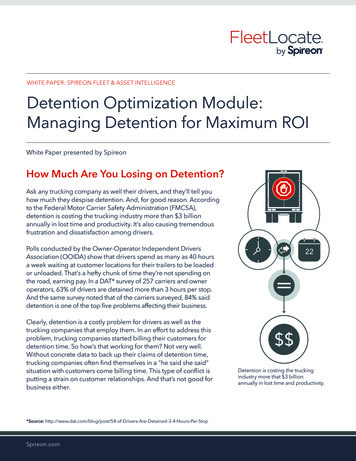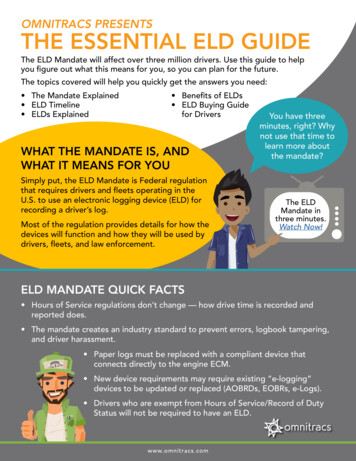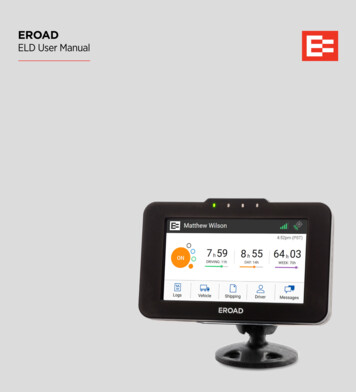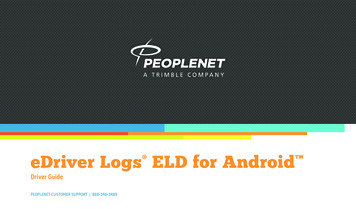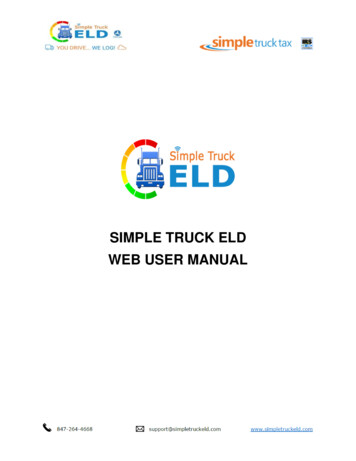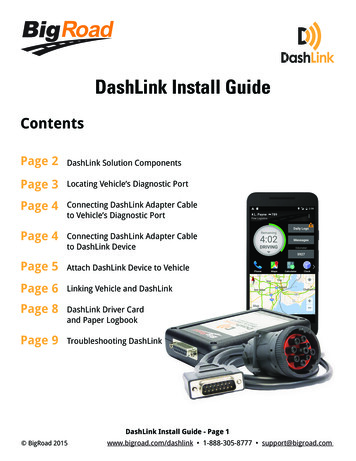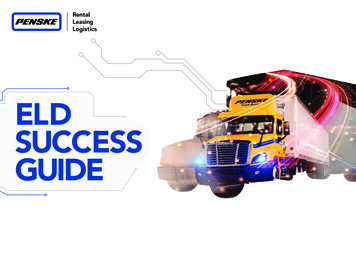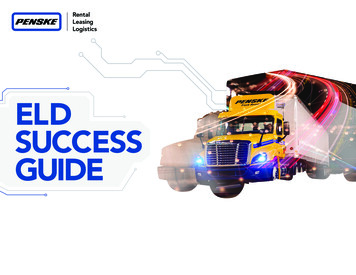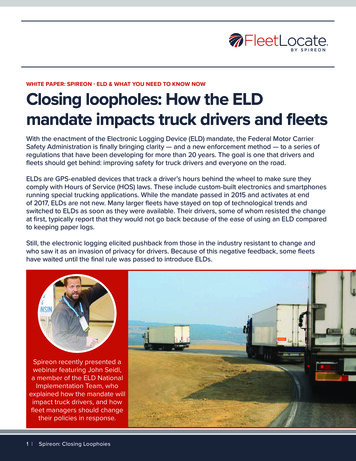
Transcription
WHITE PAPER: SPIREON - ELD & WHAT YOU NEED TO KNOW NOWClosing loopholes: How the ELDmandate impacts truck drivers and fleetsWith the enactment of the Electronic Logging Device (ELD) mandate, the Federal Motor CarrierSafety Administration is finally bringing clarity — and a new enforcement method — to a series ofregulations that have been developing for more than 20 years. The goal is one that drivers andfleets should get behind: improving safety for truck drivers and everyone on the road.ELDs are GPS-enabled devices that track a driver’s hours behind the wheel to make sure theycomply with Hours of Service (HOS) laws. These include custom-built electronics and smartphonesrunning special trucking applications. While the mandate passed in 2015 and activates at endof 2017, ELDs are not new. Many larger fleets have stayed on top of technological trends andswitched to ELDs as soon as they were available. Their drivers, some of whom resisted the changeat first, typically report that they would not go back because of the ease of using an ELD comparedto keeping paper logs.Still, the electronic logging elicited pushback from those in the industry resistant to change andwho saw it as an invasion of privacy for drivers. Because of this negative feedback, some fleetshave waited until the final rule was passed to introduce ELDs.Spireon recently presented awebinar featuring John Seidl,a member of the ELD NationalImplementation Team, whoexplained how the mandate willimpact truck drivers, and howfleet managers should changetheir policies in response.1 Spireon: Closing Loophoies
ELD rule brings accountability to trucking industry, and a new regulatory burdenA properly implemented ELD program will help fleets recruit and retain the best driving talentbecause it protects drivers from unsafe conditions. It proves that fleets treat their drivers withrespect and will never coerce them to bend or break laws to deliver a load faster. But, in order toimplement it properly and avoid violations with the FMCSA, fleet managers need to thoroughlyeducate themselves and their drivers about the new policies.With the competitive pressure on shipping companies to deliver freight sooner, and paymentcontracts for truckers that often reward driving farther or faster, a culture has developed amongsome members of the trucking industry of looking the other way around HOS violations. HOS lawsset caps on maximum driving time and minimum rest time for different types of commercial drivers,and they are relatively easy to bend or break without getting caught when only using a papersystem. The ELD mandate was developed to hold drivers and fleets accountable to observingthese laws.Since they are plugged into the engine, ELDs eliminate many of the ways drivers and fleets haveexploited loopholes or blatantly ignored laws in an effort to deliver shipments faster. However,even with GPS tracking, there are still opportunities for drivers to record fraudulent time logs in anELD, depending on the settings of the devices, and the policies that are in place.Spireon recommends creating policies that eliminate any chance that drivers could record falselogs and trigger an audit/investigation. Better policies protect the drivers and will keep yourCompliance, Safety, and Accountability (CSA) score higher, helping fleets attract the best drivers inthe workforce. In this situation, the incentives align well with the intended consequences.2 Spireon: Closing Loophoies
To give you a full understanding of the new program, this paper will review the history, theimportant dates, challenges you might encounter in implementing the program, policies that willhelp you protect your drivers and keep your fleet in compliance, and some notes for selecting thebest device for your fleet.Whether you already have devices or whether you’re in limbo with your decision, this will serve asa primer on everything you need to know to successfully comply with the new law.The ELD mandate: A rule 27 years in the makingThe federal government first introduced the concept of electronic time logging for truckers in 1988with the Automatic Onboard Recording Device (AOBRD) Final Rule. This legislation governedthe trucking industry until 2007, when the federal government proposed a rule to mandate thatevery truckingcompanyhad a tobadBereviewin the United States by the government wouldWhenDo thatI NeedCompliant?have to implement these for two years. That rule was never implemented because of a series ofmodifications,lawsuits and comment periods to take into account driver concerns. The end resultThere are two key dates to be aware of to ensure your fleet stay’s compliant:of eight years of negotiations was the ELD mandate, passed in 2015, which requires truckers toupdate from technology that is now almost three decades old.1. The ELD Mandate Effective Date – December 18th, 2017Important datesELDrulethatcomplianceAfter thisfordate,any fleetdoes not qualify under the grandfather clause by having an AOBRD in usemust be equipped with an ELD Mandate-compliant device to remain in compliance.Trucking companies and owner/operators who have been dragging their feet hoping this rulewould be overturnedbeforeits compliancedeadlinenow face a quick turnaround to upgrade their2. The End of theGrandfatherPeriod – December18th 2019fleets. By December 18, 2017, every trucking company needs to have either an AOBRD or an ELDThe grandfather clause enables any vehicle that adopts an AOBRD in advance of the effective date (Deinstalled andoperatingintoeverytruck, unlessexemptfromthe(Decemberrule. By18th,December2019,cember18th, 2017)remain compliantthrough theythe endareof theGrandfatherPeriod2019).Afterdate, AOBRD’swilleveryno longerbe a compliant trucksolution.must have an ELD.AOBRD’s willbethisobsolete,andnon-exempt20192017DEC18Note: The grandfather clause does not cover new vehicles added to a fleet after the ELD Mandate effectivedate. Any new vehicles will need to be equipped with an ELD Mandate Compliant device.3 Spireon: Closing Loophoies
HOW THE ELD MANDATE WILL BE ENFORCEDOfficers will enforce compliance with the ELD mandate through routine traffic stops for trucks.Under the new mandate, drivers will be required to demonstrate compliance by presenting certaindocuments, sharing data sets, or verifying settings on the ELD during these stops. Documents that must be available at roadsideWhen drivers get pulled over, they need to be able to show the officer a graph-grid display of theiron-duty and off-duty time. There are a few options that satisfy this rule, Seidl says. First, they canprint a hard copy directly from their ELD, if it’s enabled with a printer. Second, they can show theofficer a digital display on the ELD. In addition, the officer may ask the driver to transfer the datafile of their driving activity. ELDs must come with the ability to transfer data files via email, wireless,Bluetooth, or USB. Preparing for and responding to ELD malfunctionsAn officer will also inspect whether a driver is prepared to handle a malfunction of the ELD, whichcould happen for a variety of reasons, including loss of cellular service or damage to a connectingcable. If the ELD fails, the driver must immediately begin filling out a paper log for all duties goingforward, and must reconstruct the previous seven days’ duties to be able to show them to aninspector.There are three options for reconstructing the log. The driver can recreate it on paper by copyingfrom the electronic version on-file with the fleet manager or stored online. They can receive anelectronic version from the fleet manager and keep that accessible on another mobile device4 Spireon: Closing Loophoies
besides the failed ELD, or they can use a mobile device to access the log on the cloud at any time(without requiring a fleet manager to email a file). This option is preferred because it is the mostreliable and least disruptive to the driver’s workflow, Seidl says.In order to prove that they are prepared for a failure, the driver must have blank Records of DutyStatus logs for at least 7 days on hand at all times. The driver is also required to keep an instructioncard explaining the operation of the ELD in the truck at all times. This requirement is consistentwith the original 1988 AOBRD Final Rule. Seidl says that despite being a simple task, many drivershave been docked for failing to maintain these blank forms and instruction card in the truck.“Search any company you want that you know has had these things for a long time,” Seidl says.“Look at their hours of service violations, and you’ll see that these are the one and two most citedviolations with companies that have had AOBRDs for years.”If an ELD does fail, it must be repaired within eight days, or else the truck risks being placed out ofservice, Seidl notes. Properly using the ELDA roadside inspection will also evaluate whether a driver has used the proper form and manner toinput the vehicle information, shipping ID, personal login, and duty mode into the ELD. To minimizeroom for error, it’s best to set the preferences on your fleet’s ELDs to automatically fill in theinformation that doesn’t change daily, like VIN number.The duty mode refers to the four options for a driver to log their time: on-duty driving, on-duty notdriving, off-duty, and personal conveyance. These modes are covered in more detail later in thispaper, when we discuss potential violations.One notable change between AOBRDs and ELDs is that drivers must now use their driver’s licensenumber as their login, instead of a custom login assigned by the company. This change wasnecessary because some fleets assigned multiple logins to drivers, allowing them to fool the ELDinto thinking there were two drivers, instead of one driver exceeding HOS limitations.Understanding the potential violations and challenges of implementing the ELD mandateThe FMCSA will enforce the ELD mandate through periodic compliance reviews. These could berandomly scheduled, or could be triggered by things such as a roadside inspection that foundviolations or a complaint from a driver. Fleet managers must be vigilant about reviewing driver logsto make sure they are not committing these violations, so that they can discipline drivers internally.“If you’re not paying attention to this, the drivers are going to start doing it and the investigatormight be the one to find out, and trust me, you want to find this before the investigator,” Seidl says.5 Spireon: Closing Loophoies
Unidentified driver violationThe most likely violation that could occur under the ELD mandate is also the most obvious andeasiest to catch: if a driver decides not to login to the device and drives anyway. Knowing that thedevice would record an HOS violation if it was logged in, the driver might hope to get away withsaying, “Oops, I forgot to login.”Seidl says these violations are easy to catch internally. He related the example of a driver whoselog showed him ending the day in Lima, OH, and starting the next day in Reading, PA, 518 milesaway.“What I suggest is you teach drivers how this works and how you catch them to prevent them fromtrying it,” Seidl says.Improper use of Personal Conveyance and Yard MovesThe new rule includes two terms that are not well defined and could cause some confusion amongdrivers: “personal conveyance” and “yard moves.” To avoid violations, fleet managers must clearlydefine personal conveyance and yard moves and make sure drivers understand when they can beused and when they cannot.Personal conveyance means driving a vehicle while off duty. To be off-duty, a driver must not beperforming any commercial purpose, must be driving a short distance, and must not be carryingfreight. One area of confusion is that the FMCSA did not define how long a “short distance” is.Seidl says he recommends that fleets set a standard distance, whether it’s 10, 15, or 20 miles.Since using a commercial vehicle for personal conveyance means the driver can select ‘off-duty’in the ELD, it’s important that fleets clearly explain the situations when personal conveyance isacceptable, and make sure that drivers don’t use it to hide HOS violations.Yard moves refers to any time a driver moves the truck while on-duty, but is not on “driving” dutystatus. It’s intended for short moves around a truck yard and defined as driving on a non-highway.Drivers should take note, however, that “highway” has a broad definition according to the FMCSA.Any road, street or way passable by standard four-wheeled passenger cars that is open to thepublic is a highway.6 Spireon: Closing Loophoies
Driving a truck under the Yard Moves status does not eat into driving hours, which is why, in thepast, it has been used as a loophole to extend the driving day.“Yard moves is something a lot of people are going to start using to protect their driving time,”Seidl says. “With a paper log, you would just drive and somewhat falsify—again, illegally—but thosedays are coming to an end.”Since personal conveyance requires that the truck is not carrying freight, it can’t be used whena driver gets to a destination and wants to drive to a motel or a truck stop to spend the night ifthe truck has not been unloaded, or the driver can’t unhook from the trailer. In situations like this,fleets need to make sure their policies clearly outline what to do if a shipment is running late anda driver runs out of driving hours before making it to a safe place to spend the night. Fleets shouldestablish a policy for what to do if the driver is forced to leave a location and has to improperly usepersonal conveyance. This could include sending a message to the fleet manager to documentwho or what forced them to leave.Back office auditing tasksIn addition to auditing driver logs to make sure they are not failing to login or improperly usingpersonal conveyance or yard moves, fleet managers must also regularly audit driver logs to checkfor other ways they might be trying to squeeze more driving time out of a day. One of theseconcerns fueling. Drivers must count fueling time as “on-duty, not-driving,” but some drivers havetried to use “off-duty.” The ELD is programmed to allow this, even though it breaks HOS laws.“If a driver wants to choose off duty while he’s fueling, he can physically do it,” Seidl says. “It’s afalse log, but he can do it and the ELD’s not going to stop him because it doesn’t know what he’sdoing when the truck’s not moving.”Another back-office duty that is crucial to avoid violations is submitting supporting documentswithin 13 days of an audit request. These documents provide additional evidence to back up theELD’s record of the driver’s use of time. Thus, the documents must identify the driver, the date, thelocation, and time. A toll receipt, or a bill of lading from a shipper are good examples.7 Spireon: Closing Loophoies
Vehicle motion settings on the ELDUnder the guidelines set by the FMCSA, it is acceptable for the ELD to wait to record drivingtime until the vehicle hits a speed greater than 5 miles per hour. Because of this, many ELDs areprogrammed to this setting by default. But Seidl recommends changing that to 0 miles per hour toprevent abuse.“I just heard a story from a trucking company about a month ago,” he says. “They had a driver thatdrove 3 miles per hour to get from one location to another on a road, which is completely unsafe,so he could keep his log in the off-duty status. It’s crazy to think that that could potentially happen.”Messaging and communication policiesDuring the eight-year period of deliberation and debate about the ELD mandate from 2007 to 2015,one of the major delays came from a lawsuit by a group representing drivers, who were concernedthat ELDs would lead to harassment of drivers and a violation of their privacy. In an effort toaddress these concerns, the FMCSA made a rule that if drivers are expected to respond to urgentmessages coming through the ELD during 30-minute breaks or 10-hour breaks, that interruptioncounts as on-duty time.“If you send repeated messages through any kind of communication, ‘repeated messages’ iskey, you cannot consider that off duty,” Seidl says. “What we really need to do is train our driversand train our dispatchers not to demand messages to be communicated back and forth duringmandatory 30-minute breaks and/or 10-hour breaks.”Log editingIn most situations, drivers can’t edit driving time after it has been logged in an ELD, since GPS andengine data are considered indisputable. But they can edit all other types of duty time after it hasbeen logged, allowing for drivers to correct mistakes. One exception to this is in the case of a teamof two co-drivers. If the new driver forgets to logout and log back in under their own license atthe switch, the drivers can agree to retroactively edit the time to account for the actual time of theswitch.Since there are still opportunities for drivers to falsely record their duty hours when the truck is notmoving, fleet managers must confirm any edits that are made to make sure the driver is not tryingto squeeze more hours out of his day.8 Spireon: Closing Loophoies
Best practices for complying with the ELD mandateBoth a driver’s and a fleet’s reputations are at stake under the new ELD mandate. If a driver violatesthe rules, it could impact the fleet’s CSA score, and worse, could result in the truck being placedout-of-service at roadside. Only certain violations will result in this immediate restriction fromdriving, and they include: Using an unauthorized ELD Violating ELD exemptions (Using an exempt category that doesn’t apply to you) Failure to reconstruct a log after an ELD malfunction Driving with a malfunctioning ELD for more than 8 days Starting April 2018, failing to transfer the duty log data file to an inspector at roadsideIf a vehicle is placed out-of-service at roadside, the violation must be fixed before it can be drivenagain, which would require servicing it on the side of the road or towing it to an appropriatelocation, which are both expensive options.Seidl sums up the most important policies to enforce in your fleet.“Don’t log off and drive,” he says. “Make sure your form and manner is right. Turn your supportingdocuments in within 13 days. If forced to leave a location, follow the policy.”Providing thorough education about the new policies and equipment, and enforcing them strictly,will keep fleets in compliance and safer.9 Spireon: Closing Loophoies
Who is the right certified ELD provider for your needs?The type of ELD that a fleet installs can impact the driver’s experience. Some devices, likeSpireon’s, take the opportunity to provide value-added services to drivers, such as helping themstay connected to family while on the road, and value-added services to fleets, such as providing afull fleet management solution that incorporates driver behavior monitoring.Other devices are more bare bones, focusing on strict compliance to the regulation. Some arecustom-built hardware that cannot be used for other purposes, some are simply a pre-programmedmobile device.The variety of choices means fleets should evaluate their needs carefully before choosing adevice. But there’s another reason they should do careful research before purchasing a device. TheFMCSA is not actually taking on the task of certifying whether devices function as advertised andin a way that prevents HOS violations.To become a certified ELD provider, manufacturers testify that their products comply with theregulation, but the FMCSA does not verify their claims unless there is a complaint.All certified ELD companies are listed on the FMCSA’s website, but this list should be taken with agrain of salt, Seidl says.“Buyers beware: Some of the best vendors in the country are not on the list yet, so just becausethey’re on the list, don’t think that it’s all good,” Seidl says.10 Spireon: Closing Loophoies
Some of the larger, more established
card explaining the operation of the ELD in the truck at all times. This requirement is consistent with the original 1988 AOBRD Final Rule. Seidl says that despite being a simple task, many drivers have been docked for failing to maintain these blank
